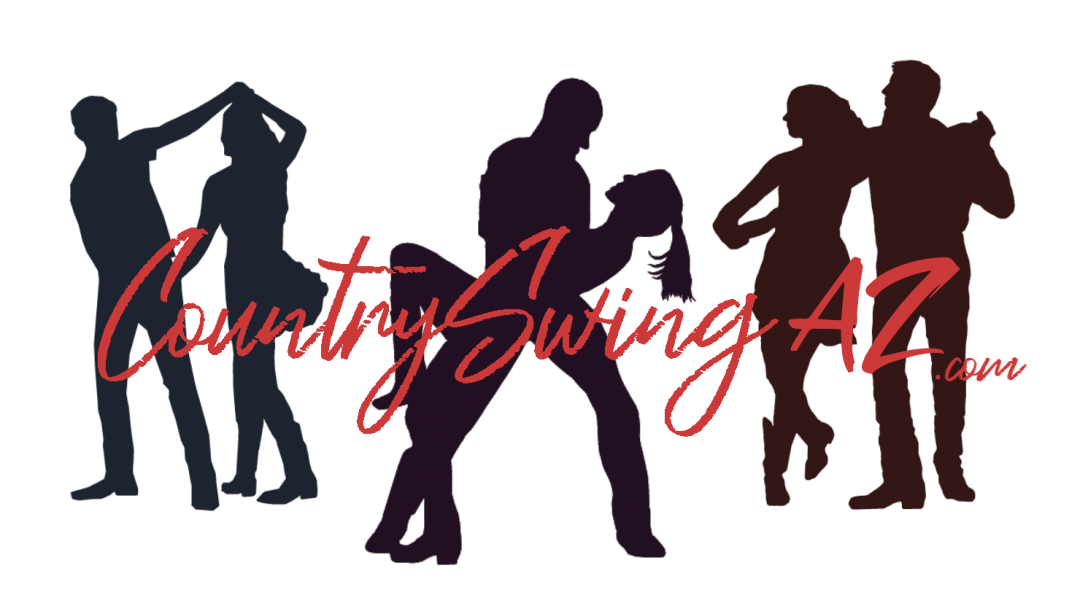Type Turn
Level Level 6 Intermediate
Other Names Double Chicken Wing
Comes From Cross-Handed Open Position, Crossed Arm Slide, Belt Loop (end with Cross-Hand Grip), Sliding Door, Sliding Door Dip, Tunnel
Leads To Cross-Handed Open Position, Break Up, Fall For Me Dip, Toss Away Spin, Tunnel
Description
The Tabletop is a cross-handed move where the lead bends from the waist to sweep his arm across his back, then leads the follower to do the same.
Steps are given for the lead, except where indicated.
- Get into the Cross-Handed Open Position, ending with a right-to-right hand hold. An easy way to do this is with an Arm Slide.
- Bring the left hand over top for an upside-down handshake grip.
- Start to move to your follow’s left side by stepping with your Right foot then the Left. Meanwhile, turn your follow under both arm “arches”. Both of you will reorient 90-degrees clockwise.
- First, you turn away. Set it up before your follow finishes her turn: Immediately after she clears your right arm, bring that arm over your own head and do 3/4 of a turn to the right. Meanwhile tuck your left arm down and behind your back like a chicken wing.
- When you are 1/4 of the way back around, duck under your left arm and finish the last 1/4 of your turn. Your right arm stays low, your left arm sweeps your back.
- As you stand straight up again, drive your left arm forward and up between you and your follow. Stay facing your partner from here on out.
- For the follow’s turn, continue to bring your left arm up and over the follow’s head as she turns to the left, and tuck your right hand down and behind her back to make a chicken wing.
- The follow should duck and sweep under the lead’s arm.
- End face-to-face in cross-handed open position. Continue with one of the suggested moves.
Tips
Leads
- Stay relaxed and loose–no tension in your arms, hands or shoulders.
- Virtually the entire move is done with cupper finger-to-finger hand grips.
- Safety is more important than staying on beat. The timing comes with practice.
- Do not over-rotate after you duck. Instead, stay facing your follow after that step.
- If the follow gives you tension and resists being put into a chicken wing for the second half of the Tabletop, you cannot force her to do it (you can try, but you might dislocate her shoulder). It’s okay, try this recovery move instead: release the right hand, and let her spin with the left hand. With your right hand free, trace her back to her left elbow and reconnect in Open Position (basically, the Belt Loop with the wrong hand).
- If the follow doesn’t understand that you want her to duck for her half of the tabletop, you can straighten your left arm and push it down to drive her under your right arm. This is the only time you can apply force.
Follows
- Stay relaxed and loose–no tension in your arms, hands or shoulders.
- Do not over-rotate after you duck. Instead stay facing your lead.
- A common mistake is to apply pressure or tension with your right shoulder and thus resist being put into a chicken wing. Hopefully your lead knows how to recover. If not, there’s no shame in letting go. But if you’re reading this website, you’re learning it the right way, so you won’t get yourself into that situation to begin with, right? 😉
Variations
- The lead can do his part of the move and leave off the rest for a Half Tabletop. Do a Double Lasso or The Break Up to finish. This is useful if you’re unsure whether your partner knows the Tabletop.
- This move can also be done continuously.
- You can do it in combination with the Tunnel, Double Lasso, and cross-handed moves.


[…] Leads To Cuddle, Tabletop […]
LikeLike
[…] To Waterfall, Outside Turn, Tabletop, Lasso, Double Lasso, Toss Away Spin, Roll Off, The Chase, Tornado, Bow and Arrow, Fall For Me […]
LikeLike
[…] To Cuddle, Tabletop, Sliding Door […]
LikeLike
[…] To Tabletop, Duck Under Spin, Double […]
LikeLike
[…] From Cross-Handed Open Position, Spinneroo, Tabletop, Double […]
LikeLike
[…] Leads To Inside Turn, Shadow Position, Wrap Up Dip, Break Up, High Five Spin, Back Lean, Side Lean, Hip Push Spin, Tabletop […]
LikeLike
[…] To Tabletop, Duck Under Spin, Double Lasso, Window, High Five Spin, Crossed Arm […]
LikeLike
[…] keeps leaving and coming back, just like this move.” It combines elements of the Belt Loop, Tabletop, The Lean and Bow & […]
LikeLike
[…] From Tabletop, Double Lasso, Crossed Arm Slide, Low Shadow […]
LikeLike
[…] In this combo, the leader guides the follower through his arms and around his back, then turns under twice in a Tabletop. […]
LikeLike